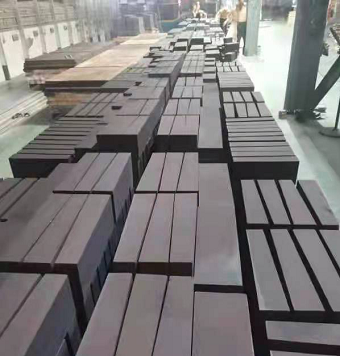Introduction of direct combined chrome magnesite bricks
Apr 14, 2022
Since the chromium oxide (Cr2O3) contained in chrome magnesite bricks can continue to diffuse, magnesia-chrome bricks can be easily attached to the kiln skin, so in the past 30 years, it has been Cement kiln firing zone recommended refractories.
Direct bonded chrome magnesite bricks is a product made of high-purity or sub-high-purity sintered or fused magnesia and chrome concentrate. The product has few impurities. After high temperature and ultra-high temperature firing, the glass phase is concentrated in the triangular area of the crystal phase, and the crystal phase and the crystal phase are directly combined. It has low porosity, high compressive strength, strong wear resistance, corrosion resistance, thermal shock resistance and good spalling resistance.

Directly bonded magnesia-chrome bricks are made of high-purity sintered magnesia and chromite with SiO2 less than 2% by high temperature sintering. Between the magnesia-chromium grains is the direct combination of periclase periclase or periclase spinel, and a small amount of silicate is isolated between the grains. During the firing process of the direct bonded brick, the silicates in the gaps of the chrome ore particles gradually move into the matrix as the temperature increases, so that the chrome ore particles come into contact with the periclase, and diffuse and dissolve into the periclase crystal. At high temperature, the periclase and chrome ore in the matrix part are dissolved in silicate, and when cooled, they precipitate as desolubilized particles secondary spinel or secondary periclase in the periclase crystal and grain boundary, making it A direct combination of periclase to periclase and periclase spinel is formed, and a small amount of silicate phase is isolated between the grains. As the sintering temperature increases, the dissolution at high temperature and the precipitation during cooling increase, and the degree of direct intergranular bonding increases.
Directly bonded bricks are widely used in open hearth furnace tops, electric arc furnaces, copper smelting converters, flash furnaces, RH, DH vacuum treatment devices, out-of-furnace refining VOD furnaces, AOD furnaces, cement rotary kilns, etc.
Relevant information
-

Main properties of magnesium oxide refractory
Performance characteristics of magnesia refractories and other basic refractories Performance characteristics of magnesia refractories and other basic refractories Refractories containing more than 80% ... -

What properties of lightweight insulation fire clay bricks can be improved by the addition of kyanite?
Lightweight insulation fire clay bricks are a kind of shaped refractory material with clay as the main raw material, which is processed, shaped, dried, and calcined with clay. on the kiln. Due to the r ... -

How is the effect of white fused alumina abrasive used in refractory materials?
After mixing, forming, drying, and firing at high temperature in a shuttle kiln. The product has the characteristics of high refractoriness, good thermal shock stability of white corundum, high high te ... -

Characteristics of refractory magnesia chrome bricks for lime kiln
Lime kilns are mainly classified into square kilns and circular kilns. According to the classification of fired products, they can be divided into lime kilns, ceramic kilns, cement kilns, glass kilns, ...

